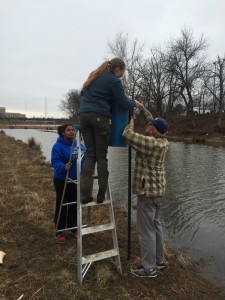Reina will be starting at West Virginia University this fall where she’ll be working with Dr. Chris Rota in the Wildlife and Fisheries Resources Program in the Davis College School of Natural Resources. Reina’s MS research will focus on the population ecology of eastern wild turkeys in northeastern South Dakota. She will be working with Dr. Chad Lehman and other members of the South Dakota Game, Fish, and Parks Department while completing her field research. Congratulations to Reina on this great opportunity!
Month: March 2016
Congrats to Adam Kautza on new position with Massachusett’s Dept. of Fish & Game
Adam has recently accepted a position as the Coldwater Fishery Resources Project Leader with the Massachusetts Department of Fish and Game, Division of Fisheries and Wildlife. Among other duties, Adam will be responsible for writing coldwater fishery resource management plans, analyzing fishery and other aquatic resource data, developing recommendations, and undertaking actions to identify, protect, maintain and restore coldwater fishery resources and their habitats. Adam is currently completing a postdoc at the University of Minnesota (Fish, Wildlife, and Conservation Biology). Congrats to Adam!
STRIVE Lab members place Wood Duck boxes as part of new monitoring project
With the winter months melting away, migratory waterfowl have begun to race north to secure their nesting habitat for the upcoming breeding season. The Olentangy and Scioto Rivers are important riparian corridors for waterfowl migration within the Mississippi Flyaway. STRIVE lab research assistant, Reina Tyl, has been busy building wood duck (Aix sponsa) boxes to place along the Olentangy and Scioto Rivers as part of the conservation of riparian birds research project. Wood ducks are cavity nesters, meaning that they naturally lay their eggs in hollowed out parts of trees. Where natural tree cavities are not available, wood ducks will nest in man-made boxes built to mimic natural tree cavities.
The wood ducks boxes, constructed from water softener tubes, are filled with an approximately 4″ deep layer of wood shavings to provide nesting material for the wood ducks. Wood ducks, unlike some other birds, do not construct nests or bring material into their nesting cavities.
STRIVE lab members (left to right) Travonya Kenly, Reina Tyl, and Lars Meyer secure a wood duck box to a post. The box opening is facing the Olentangy River, so that passing wood ducks will be able to take notice of the available nest habitat. The boxes are placed so that the openings will face east in order to reduce the amount of rain and wind that will be able to enter the boxes from the west.
STRIVE lab members (left to right) Lars Meyer, Reina Tyl, and Travonya Kenly are all smiles setting up a wood duck box across from the ‘Shoe!
Reina Tyl posing with a newly placed wood duck box in one of the wetlands at the Olentangy River Wetland Research Park.
Riparian Patchiness Plays Important Role in Ant Trophic Dynamics
New article from STRIVE lab links riverine landscape heterogeneity to ant trophic position and breadth:
Tagwireyi, P. and S.M.P. Sullivan. 2016. Riverine landscape patches influence trophic dynamics of riparian ants. River Research and Applications. doi: 10.1002/rra.3009
ABSTRACT: Food webs in riparian corridors are increasingly viewed as embedded in complex riverine landscapes characterized by an amalgam of aquatic, semi-aquatic, and terrestrial habitats. However, the influence of riverine landscape pattern on trophic dynamics of riparian consumers remains largely unknown. We used naturally abundant stable isotope ratios (δ15N) to compare trophic structure of ants (Formica subsericea) among riparian patch types (crop, grass/herbaceous, gravel bar, lawn, mudflat, shrub, swamp, and woody vegetation) at 12 riverine landscapes distributed along an urban-rural landscape gradient of the Scioto River, Ohio, USA. We expected that the diet of F. subsericea, a common generalist consumer, would reflect local prey availability and thus differences in trophic dynamics among patch types. Mean ant δ15N was higher in crop patches than in any other patch type, and was lowest in grass/herbaceous, lawn, shrub, and woody vegetation patches, sugges- ting that patch type was associated with trophic position of F. subsericea. We also found that the range of δ15N, and thus trophic breadth, was significantly different by patch type, with woody vegetation exhibiting the greatest spread. Variability in canopy, tree and shrub cover, and the degree of urban development was positively correlated with δ15N range (R2 = 0.78), pointing to the role of habitat structure in mediating trophic breadth of riparian ants. These findings provide evidence that riverine landscape pattern can strongly influence trophic dynamics of riparian arthropods.





